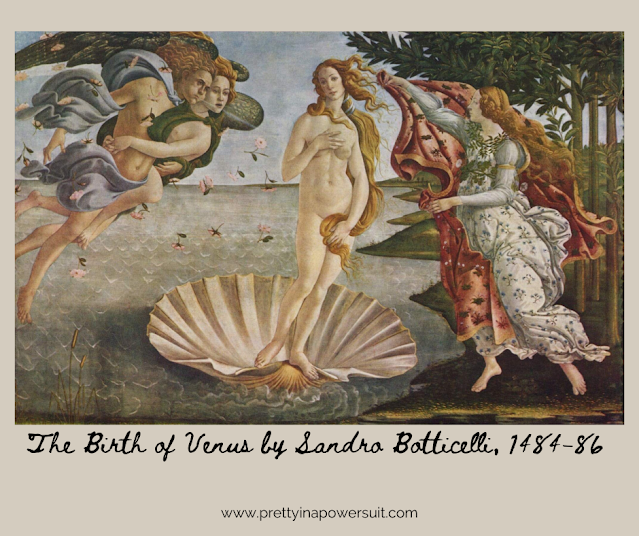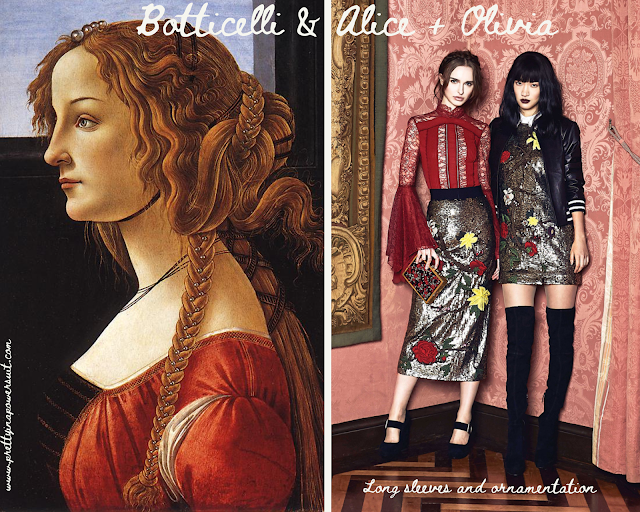Graceful, ethereal, romantic, mysterious. The women of Sandro
Botticelli’s paintings from the Italian Renaissance continue to awe and inspire
art lovers and fashion designers. Centuries since women like Venus were
depicted on the 15th century canvases, the paintings’ power to
enthrall remains.
Botticelli became famous for his depictions of women, including the goddess of love, Venus. In The Birth of Venus painting, Venus arrives on the shoreline ready to be dressed in a luxurious fabric with a floral design.
Mythological women including Venus and The Three Graces were painted by Botticelli again in the last 1470s or early 1480s in Primavera. In this work, the characters were painted against the backdrop of a lush garden and orchard, which helps connect the painting to ideas of love,
fertility and the arrival of spring.
The famous Primavera painting was likely commissioned by
the Medici family during Renaissance. For several generations, the Medicis held seats of power
through business and politics in Italy. In addition to generating large sums of
money for their family, they also heavily invested in the arts and humanities.
By doing things like supporting artists that included Botticelli, the family
helped make Florence the heart of the Italian Renaissance.
Upper right: Portrait of Lucrezia de'Medici by Agnolo Bronzino, 1560, via WikiArt
Lower left: Portrait of a Young Woman (Simonetta Vespucci as Nymph) by Sandro Botticelli, 1480-85, via Wikipedia
The Alice + Olivia Fall 2017 collection clearly drew
inspiration from the Primavera painting with skirts depicting scenes from the
painting. Elements throughout the collection mirrored the spirit not only the Primavera painting, but Renaissance fashion as a whole. In the above designs, there are embroidered fabrics and rich hues that are reminiscent of fashion worn by Renaissance women, including Lucrezia de'Medici.
The characters from Primavera got a new canvas in the form of skirts depicting the painting. The skirts from Alice + Olivia are full and provide volume to showcase the print, while also mirroring the full-skirted silhouette of a Renaissance woman. The skirts are paired with blouses that feature long and flowing sleeves, much like the sleeves of a wealthy woman of the Renaissance era.
Renaissance dresses were
typically fitted at the top with either a high neckline or V-neck. The waist
was accentuated as the smallest part of the body and may have been highlighted
by a belt. Past the waistline, the dresses were often pleated or gathered before falling to the floor in a full and voluminous cascade of fabric. In the above Alice + Olivia nude colored ensemble, the skirt has a fitted waist and the cloak cascades in a luxe velvet like the dresses would have in the Renaissance. In shades of nude, the ensemble mimics the delicacy of the gowns worn by The Three Graces, but without actually revealing any skin.
During the Renaissance, wealthy women were often inclined to select richly colored
fabrics in jewel tones. Fabric choices included velvets and brocades, with
accents of jewels and ribbons. The key to every fashion choice of the time was
extravagance and luxury. As FIT points out, fashion for women of that time was
intertwined with “beauty and social expectations of women” with choices often
designed to underscore wealth, power, position and marriage status.
The Alice + Olivia designs used key parts of the Renaissance style repertoire with the richly hued fabrics that were also embroidered and decadent. In the above design, the birds and flowers on the Alice + Olivia design mirror the natural symbolism seen on the girl ready to dress Venus.
Portrait of Simonetta Vespucci by Sandro Botticelli, 1476, via Wikipedia
Several of the designs featured long sleeves, including
romantic bell shapes as with the red blouse seen above. This too drew inspiration from the Renaissance since
women’s dresses with long sleeves were worn to show wealth. A woman with long
sleeves was prosperous and did not need to work like the lower class, and her
sleeves made work an impossibility since they were not practical for the
demands of labor.
Nowadays, women can of course wear long sleeves no matter
their class. But just as women of the 14th and 15th centuries selected their attire to communicate messages, fashion continues to
hold the power to tell parts of our stories each day.
Additional Image Sources
Image details from The Birth of Venus and Primavera via Wikipedia
Fashion photos by Alice + Olivia via Vogue
Sources & Further Reading
1. "Beauty Adorns Virtue: Italian Renaissance Fashion" on the FIT Fashion History Timeline
2. "History of Italian Fashion" on Wikipedia
















